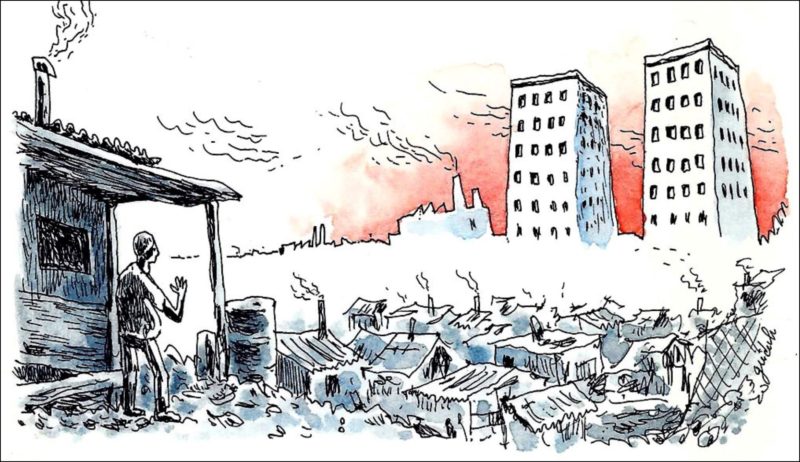In search of:
Part II
France: A look back at a history of migration
by Fabia Wong
Contributing Columnist
In the late autumn of last year, my husband and I cycled along the Canal du Midi, a 17th Century feat of engineering that traverses 240 km of southwest France. We were captured by the tranquil beauty of the Hérault – a landscape of gently rolling hills and vineyards, saturated with tones of evergreen, ochre, and deep red. Long stretches of the Canal are lined with platane trees that have stood for hundreds of years, and powerful white mares with yellowed manes yet roam the fields. The countryside, dotted with hamlets and farms, and many of the villages seem untouched by the passage of time.
 The foundational story of France spans millennia, from the Gauls, the Roman invasion and the Merovingian kings, to bloody revolution, empire and the Republic, now in its fifth iteration. Each civilization, changing of hands and spillage of blood has left an indelible mark on a profoundly complex culture, one that is so often presented as a monolith but is far from it. As General De Gaulle questioned, comment voulez-vous gouverner un pays qui a deux cent quarante-six variétés de fromage? Equally as varied is the conversation around the changing face of France.
This is where we hope to put down roots and build our lives. It is the third country I have called home this last decade, having left Canada for the Netherlands seven years ago, and for France last year. To me, France is a country of natural beauty and man-made elegance, transcendence and passion for life, philosophy and tradition, and of revolution. It is an ancient country, facing new challenges and that makes it a fascinating and occasionally unnerving time to relocate here. The discourse surrounding race, culture and immigration differs dramatically from the North American one I have grown up with – unsurprising, given the vastly different histories, peoples and pressures at play.
Still, there are instances of convergence. For instance, the Hérault apparently served as an inspiration for Renaud Camus’ Le Grand Remplacement, a relatively marginal conspiracy theory that has received increased coverage, partly it seems because of the light shone upon the theory by The New Yorker, for its impact on the American far-right.[1] This theory advances the notion that forces of globalization condemn the (white) “French people” to be overtaken, outnumbered and eventually demographically eliminated by people from the Maghreb and sub-Saharan Africa – notwithstanding the fact that the statistics collected by the relevant national institutes simply do not support this possibility.
And in the context of migration, in some ways the European crisis and the accompanying political evolution mirror what is happening in North America. The emblematic migrant at the center of these crises falls squarely into the category of “other”, by virtue of his skin colour, faith or both. And so, as the collective compassion of the West has plummeted, far right, openly xenophobic parties have risen to or are rising to power in several EU member states. As addressed in the first article of this two-part series, the Macron government recently introduced a series of amendments to France’s asylum law. The law, which is generally aimed at increasing the efficiency of the asylum claiming process, potentially to the detriment of claimants’ due process rights, does not address to any significant degree measures aimed at assisting new immigrants to integrate.
The foundational story of France spans millennia, from the Gauls, the Roman invasion and the Merovingian kings, to bloody revolution, empire and the Republic, now in its fifth iteration. Each civilization, changing of hands and spillage of blood has left an indelible mark on a profoundly complex culture, one that is so often presented as a monolith but is far from it. As General De Gaulle questioned, comment voulez-vous gouverner un pays qui a deux cent quarante-six variétés de fromage? Equally as varied is the conversation around the changing face of France.
This is where we hope to put down roots and build our lives. It is the third country I have called home this last decade, having left Canada for the Netherlands seven years ago, and for France last year. To me, France is a country of natural beauty and man-made elegance, transcendence and passion for life, philosophy and tradition, and of revolution. It is an ancient country, facing new challenges and that makes it a fascinating and occasionally unnerving time to relocate here. The discourse surrounding race, culture and immigration differs dramatically from the North American one I have grown up with – unsurprising, given the vastly different histories, peoples and pressures at play.
Still, there are instances of convergence. For instance, the Hérault apparently served as an inspiration for Renaud Camus’ Le Grand Remplacement, a relatively marginal conspiracy theory that has received increased coverage, partly it seems because of the light shone upon the theory by The New Yorker, for its impact on the American far-right.[1] This theory advances the notion that forces of globalization condemn the (white) “French people” to be overtaken, outnumbered and eventually demographically eliminated by people from the Maghreb and sub-Saharan Africa – notwithstanding the fact that the statistics collected by the relevant national institutes simply do not support this possibility.
And in the context of migration, in some ways the European crisis and the accompanying political evolution mirror what is happening in North America. The emblematic migrant at the center of these crises falls squarely into the category of “other”, by virtue of his skin colour, faith or both. And so, as the collective compassion of the West has plummeted, far right, openly xenophobic parties have risen to or are rising to power in several EU member states. As addressed in the first article of this two-part series, the Macron government recently introduced a series of amendments to France’s asylum law. The law, which is generally aimed at increasing the efficiency of the asylum claiming process, potentially to the detriment of claimants’ due process rights, does not address to any significant degree measures aimed at assisting new immigrants to integrate.

The Battle between Christians and Moors at El Sotillo
Artist:Francisco de Zurbarán (Spanish, Fuente de Cantos 1598–1664 Madrid). Date:ca. 1637–39, The Metropolitan Museum of Art collection.
“Beyond the differential treatment Algerians faced in their own territory, particularly those of the Muslim faith,
migrants to the mainland faced further exigencies. Housing was limited, resulting in the creation of slums and
bidonvilles or shantytowns built on the periphery of large cities like Paris, Nanterre and Marseille.”
Beyond the differential treatment Algerians faced in their own territory, particularly those of the Muslim faith, migrants to the mainland faced further exigencies. Housing was limited, resulting in the creation of slums and bidonvilles or shantytowns built on the periphery of large cities like Paris, Nanterre and Marseille. These unofficial settlements were left neglected by the French state for decades, and were notorious for their poor conditions of life. Where the state did decide to intervene, those incursions often involved surveillance and brutality, while basic services remained lacking for extended periods of time. For example, children inhabiting the bidonville of Nanterre were not integrated into the French schooling system until 1967.[3]
As an attempt to cope with housing the new population, in the 1950s and 1960s, the state built emergency structures around France to house workers from Maghreb, the Foyers de Travailleurs Migrants. Subsequently similar structures were built in the Ile-de-France region for workers predominantly from Sub-Saharan Africa. The structures were built rapidly at low cost, as they were initially intended for temporary use, but remain inhabited by the workers – now retired – and have aged poorly. It was only in 1997 when the State invested in their renovation with the intent to convert the buildings into social housing, a process which is still far from completion due to the complexities and expense involved in the work (e.g., the conversion of 20,000 rooms less than 7.5 square meters, or 80 sq. ft.).[4]

© Guillaume Duchemin
About the author:
 Fabia Chenivesse-Wong. Fabia studied and practiced law at a regional law firm in her hometown of Toronto, Canada, before moving to The Hague, the Netherlands, in 2011. For six years she worked for UN tribunals, prosecuting international crime. Currently based in the south of France, she writes about gender, race, culture and the law.
Fabia Chenivesse-Wong. Fabia studied and practiced law at a regional law firm in her hometown of Toronto, Canada, before moving to The Hague, the Netherlands, in 2011. For six years she worked for UN tribunals, prosecuting international crime. Currently based in the south of France, she writes about gender, race, culture and the law.
[1] Willams, T.C. (2017), “The French Origins of ‘You Will Not Replace Us’”, The New Yorker, 4 December 2017.
[2] For a more detailed discussion, see Stora, B. (2004) Histoire de l’Algérie coloniale, 1830-1954, and House, J. “The colonial and post-colonial dimensions of Algerian migration to France”, University of Leeds. Retrieved from: http://www.history.ac.uk/ihr/Focus/Migration/articles/house.html
[3] Gastaut, Y. « Les bidonvilles, lieux d’exclusion et de marginalité en France durant les trente
glorieuses », Cahiers de la Méditerranée [En ligne], 69 | 2004, mis en ligne le 10 mai 2006, consulté le 30 septembre 2016. URL : http://cdlm.revues.org/829
[4] Caisse des Depots des Territoires, «Habitat – Foyers de travailleurs migrants: un monde a part », 10 Sept 2010.
[5] Aunay, T. «Infos Migrations: Le statut d’activité des immigrés entre 1968 et 2013», Département des Statistiques, Des Etudes et de la Documentation, No. 93, février 2018.
[6] «Insee Référence – Immigrés et descendants d’immigrés en France», 2012.
[7] Brinbaum et al., « Insee Référence – Les enfants d’immigrés ont des parcours scolaires differenciés selon leur origine migratoire», octobre 2012.
 The foundational story of France spans millennia, from the Gauls, the Roman invasion and the Merovingian kings, to bloody revolution, empire and the Republic, now in its fifth iteration. Each civilization, changing of hands and spillage of blood has left an indelible mark on a profoundly complex culture, one that is so often presented as a monolith but is far from it. As General De Gaulle questioned, comment voulez-vous gouverner un pays qui a deux cent quarante-six variétés de fromage? Equally as varied is the conversation around the changing face of France.
This is where we hope to put down roots and build our lives. It is the third country I have called home this last decade, having left Canada for the Netherlands seven years ago, and for France last year. To me, France is a country of natural beauty and man-made elegance, transcendence and passion for life, philosophy and tradition, and of revolution. It is an ancient country, facing new challenges and that makes it a fascinating and occasionally unnerving time to relocate here. The discourse surrounding race, culture and immigration differs dramatically from the North American one I have grown up with – unsurprising, given the vastly different histories, peoples and pressures at play.
Still, there are instances of convergence. For instance, the Hérault apparently served as an inspiration for Renaud Camus’ Le Grand Remplacement, a relatively marginal conspiracy theory that has received increased coverage, partly it seems because of the light shone upon the theory by The New Yorker, for its impact on the American far-right.[1] This theory advances the notion that forces of globalization condemn the (white) “French people” to be overtaken, outnumbered and eventually demographically eliminated by people from the Maghreb and sub-Saharan Africa – notwithstanding the fact that the statistics collected by the relevant national institutes simply do not support this possibility.
And in the context of migration, in some ways the European crisis and the accompanying political evolution mirror what is happening in North America. The emblematic migrant at the center of these crises falls squarely into the category of “other”, by virtue of his skin colour, faith or both. And so, as the collective compassion of the West has plummeted, far right, openly xenophobic parties have risen to or are rising to power in several EU member states. As addressed in the first article of this two-part series, the Macron government recently introduced a series of amendments to France’s asylum law. The law, which is generally aimed at increasing the efficiency of the asylum claiming process, potentially to the detriment of claimants’ due process rights, does not address to any significant degree measures aimed at assisting new immigrants to integrate.
The foundational story of France spans millennia, from the Gauls, the Roman invasion and the Merovingian kings, to bloody revolution, empire and the Republic, now in its fifth iteration. Each civilization, changing of hands and spillage of blood has left an indelible mark on a profoundly complex culture, one that is so often presented as a monolith but is far from it. As General De Gaulle questioned, comment voulez-vous gouverner un pays qui a deux cent quarante-six variétés de fromage? Equally as varied is the conversation around the changing face of France.
This is where we hope to put down roots and build our lives. It is the third country I have called home this last decade, having left Canada for the Netherlands seven years ago, and for France last year. To me, France is a country of natural beauty and man-made elegance, transcendence and passion for life, philosophy and tradition, and of revolution. It is an ancient country, facing new challenges and that makes it a fascinating and occasionally unnerving time to relocate here. The discourse surrounding race, culture and immigration differs dramatically from the North American one I have grown up with – unsurprising, given the vastly different histories, peoples and pressures at play.
Still, there are instances of convergence. For instance, the Hérault apparently served as an inspiration for Renaud Camus’ Le Grand Remplacement, a relatively marginal conspiracy theory that has received increased coverage, partly it seems because of the light shone upon the theory by The New Yorker, for its impact on the American far-right.[1] This theory advances the notion that forces of globalization condemn the (white) “French people” to be overtaken, outnumbered and eventually demographically eliminated by people from the Maghreb and sub-Saharan Africa – notwithstanding the fact that the statistics collected by the relevant national institutes simply do not support this possibility.
And in the context of migration, in some ways the European crisis and the accompanying political evolution mirror what is happening in North America. The emblematic migrant at the center of these crises falls squarely into the category of “other”, by virtue of his skin colour, faith or both. And so, as the collective compassion of the West has plummeted, far right, openly xenophobic parties have risen to or are rising to power in several EU member states. As addressed in the first article of this two-part series, the Macron government recently introduced a series of amendments to France’s asylum law. The law, which is generally aimed at increasing the efficiency of the asylum claiming process, potentially to the detriment of claimants’ due process rights, does not address to any significant degree measures aimed at assisting new immigrants to integrate.

 Fabia Chenivesse-Wong. Fabia studied and practiced law at a regional law firm in her hometown of Toronto, Canada, before moving to The Hague, the Netherlands, in 2011. For six years she worked for UN tribunals, prosecuting international crime. Currently based in the south of France, she writes about gender, race, culture and the law.
Fabia Chenivesse-Wong. Fabia studied and practiced law at a regional law firm in her hometown of Toronto, Canada, before moving to The Hague, the Netherlands, in 2011. For six years she worked for UN tribunals, prosecuting international crime. Currently based in the south of France, she writes about gender, race, culture and the law.

Recent Comments